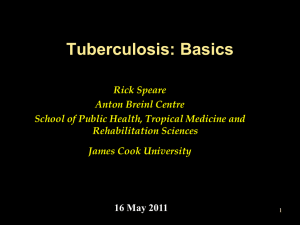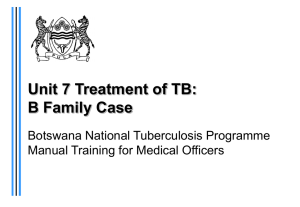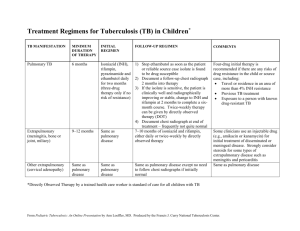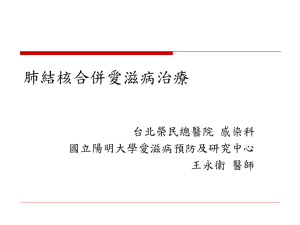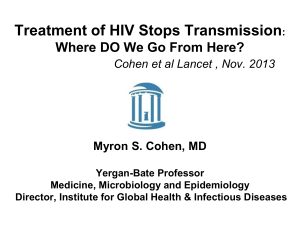study of clinical, radiological, bacteriological spectrum of pulmonary
advertisement
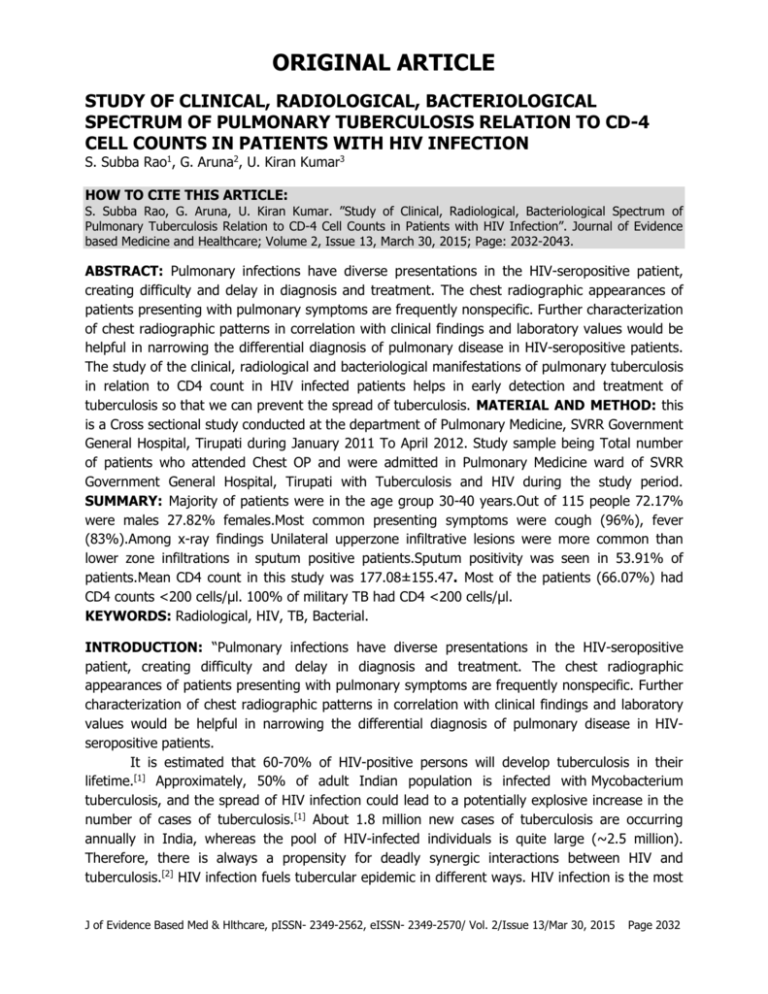
ORIGINAL ARTICLE STUDY OF CLINICAL, RADIOLOGICAL, BACTERIOLOGICAL SPECTRUM OF PULMONARY TUBERCULOSIS RELATION TO CD-4 CELL COUNTS IN PATIENTS WITH HIV INFECTION S. Subba Rao1, G. Aruna2, U. Kiran Kumar3 HOW TO CITE THIS ARTICLE: S. Subba Rao, G. Aruna, U. Kiran Kumar. ”Study of Clinical, Radiological, Bacteriological Spectrum of Pulmonary Tuberculosis Relation to CD-4 Cell Counts in Patients with HIV Infection”. Journal of Evidence based Medicine and Healthcare; Volume 2, Issue 13, March 30, 2015; Page: 2032-2043. ABSTRACT: Pulmonary infections have diverse presentations in the HIV-seropositive patient, creating difficulty and delay in diagnosis and treatment. The chest radiographic appearances of patients presenting with pulmonary symptoms are frequently nonspecific. Further characterization of chest radiographic patterns in correlation with clinical findings and laboratory values would be helpful in narrowing the differential diagnosis of pulmonary disease in HIV-seropositive patients. The study of the clinical, radiological and bacteriological manifestations of pulmonary tuberculosis in relation to CD4 count in HIV infected patients helps in early detection and treatment of tuberculosis so that we can prevent the spread of tuberculosis. MATERIAL AND METHOD: this is a Cross sectional study conducted at the department of Pulmonary Medicine, SVRR Government General Hospital, Tirupati during January 2011 To April 2012. Study sample being Total number of patients who attended Chest OP and were admitted in Pulmonary Medicine ward of SVRR Government General Hospital, Tirupati with Tuberculosis and HIV during the study period. SUMMARY: Majority of patients were in the age group 30-40 years.Out of 115 people 72.17% were males 27.82% females.Most common presenting symptoms were cough (96%), fever (83%).Among x-ray findings Unilateral upperzone infiltrative lesions were more common than lower zone infiltrations in sputum positive patients.Sputum positivity was seen in 53.91% of patients.Mean CD4 count in this study was 177.08±155.47. Most of the patients (66.07%) had CD4 counts <200 cells/μl. 100% of military TB had CD4 <200 cells/μl. KEYWORDS: Radiological, HIV, TB, Bacterial. INTRODUCTION: “Pulmonary infections have diverse presentations in the HIV-seropositive patient, creating difficulty and delay in diagnosis and treatment. The chest radiographic appearances of patients presenting with pulmonary symptoms are frequently nonspecific. Further characterization of chest radiographic patterns in correlation with clinical findings and laboratory values would be helpful in narrowing the differential diagnosis of pulmonary disease in HIVseropositive patients. It is estimated that 60-70% of HIV-positive persons will develop tuberculosis in their lifetime.[1] Approximately, 50% of adult Indian population is infected with Mycobacterium tuberculosis, and the spread of HIV infection could lead to a potentially explosive increase in the number of cases of tuberculosis.[1] About 1.8 million new cases of tuberculosis are occurring annually in India, whereas the pool of HIV-infected individuals is quite large (~2.5 million). Therefore, there is always a propensity for deadly synergic interactions between HIV and tuberculosis.[2] HIV infection fuels tubercular epidemic in different ways. HIV infection is the most J of Evidence Based Med & Hlthcare, pISSN- 2349-2562, eISSN- 2349-2570/ Vol. 2/Issue 13/Mar 30, 2015 Page 2032 ORIGINAL ARTICLE important known risk factor that favors progression to active TB from latent infection by suppressing the immune response against tuberculosis. Exogenous reinfection can also occur as HIV-infected individuals fail to contain new infections. The World Health Organization (WHO) reported in 2007 that the African region accounted for most HIV-positive tuberculosis cases (79%), followed by the Southeast Asia region (mainly India), which had 11% of total cases. Although the prevalence of HIV infection among patients with tuberculosis ranges from 50% to 80% in many settings in sub- Saharan Africa, in other parts of the world it varies from 2% to 15%.[3] Studies from India have reported HIV seropositivity rates varying from 0.4 to 20.1%.[2] On the other hand, approximately 50% of the HIV-infected people in India are co infected with M. tuberculosis and approximately 200,000 of these co infected persons will develop active TB each year in association with HIV infection.[4] Unlike other opportunistic infections, tuberculosis can occur at any stage of HIV disease, and its manifestations depend largely on the degree of immunosuppression. Twenty-five to 65% of HIV-infected persons have been reported to have active TB of one organ or the other in developing countries.[2] Despite the burden of HIV, the epidemiology of tuberculosis in India is being primarily driven by the non-HIV TB-infected pool. Several studies have described the unusual manifestations of pulmonary tuberculosis in patients with advanced stages of HIV infection, and, conversely, the usual pattern of reactivation tuberculosis in those patients early in the course of HIV infection.(5-9) These findings have been attributed to differences in alterations of cell-mediated immunity, the primary aspect of immune suppression in HIV seropositive patients. Thus, those patients, early in the course of HIV infection would be expected to present similarly to an immunocompetent individual with normal cellular immunity, while those late in the course of HIV infection may have a variable presentation, since they are less able to contain tuberculous infection secondary to depressed cellular immunity. The study of the clinical, radiological and bacteriological manifestations of pulmonary tuberculosis in relation to CD4 count in HIV infected patients helps in early detection and treatment of tuberculosis so that we can prevent the spread of tuberculosis. MATERIAL AND METHODS: Study design: Cross sectional study. Setting: The department of Pulmonary Medicine, SVRR Government General Hospital, Tirupati. Period of study: January 2011 To April 2012. Sample size: Total number of patients who attended Chest OP and were admitted in Pulmonary Medicine ward of SVRR Government General Hospital, Tirupati with Tuberculosis and HIV during the study period. CRITERIA FOR DISSERTATION: A) INCLUSION CRITERIA: 1. Age more than 15 years. 2. HIV infected diagnosed by EIA, HIV ½ Triline Card test, Retro check HIV. J of Evidence Based Med & Hlthcare, pISSN- 2349-2562, eISSN- 2349-2570/ Vol. 2/Issue 13/Mar 30, 2015 Page 2033 ORIGINAL ARTICLE 3. 4. 5. 6. Both sputum positive and negative for AFB. X-RAY showing lesions suggestive of Pulmonary Tuberculosis. Clinical features suggestive of Pulmonary Tuberculosis. Willingness of the patient to participate in this procedure. B) EXCLUSION CRITERIA: 1. Age <15 years. 2. Patients with previous H/o pulmonary tuberculosis. 3. Who used ATT for >4 weeks for Pulmonary Tuberculosis earlier. 4. Patients with other immunosuppressive diseases like. a) Chronic renal disease. b) Diabetes mellitus. c) Patients on steroids. 5. Patients who are not willing to participate in the study. INVESTIGATIONS TO BE DONE FOR THE PATIENTS: a) Chest x-ray postero-anterior view. b) HRCT Chest where necessary. c) Sputum microscopy for AFB. d) Sputum for AFB culture. e) Sputum for Gram stain and culture sensitivity for pyogenic organisms. f) Routine blood investigations (like differential count, ESR). g) HIV test by EIA, HIV ½ Triline Card test, Retro check HIV. h) CD4 cell count. RESULTS: In this study 115 HIV patients with Pulmonary tuberculosis were studied of these 83 were males and 32 were females. Male Female Total Age group No. of No. of No. of (years) % % % cases Cases cases < 21 1 1.2% 1 3.1% 2 1.73% 21-29 12 14.45% 6 18.75% 18 15.65% 30-39 40 48.19% 14 43.75% 54 46.95% 40-49 20 24.09% 8 25% 28 24.34% 50-59 8 9.63% 2 6.25% 10 8.69% > 60 2 2.45 1 3.12% 3 2.60% Total 83 100% 32 100% 115 100% Table 1: Age and Sex Distribution χ2 =1.22; P=0.94; NS. J of Evidence Based Med & Hlthcare, pISSN- 2349-2562, eISSN- 2349-2570/ Vol. 2/Issue 13/Mar 30, 2015 Page 2034 ORIGINAL ARTICLE The proportions of age groups between male and female patients is not statistically significant (P=0.94; NS). No of Patients Mean Age Standard Deviation Male 83 37.59 9.54 Female 32 34.93 9.82 Total 115 36.85 9.65 Table 2: Mean Age and Sex Distribution t=1.32; P=0.18; NS. The age of study subjects ranged from 14-74. The mean age was 36.85±9.65 (37.59±9.54 for males and 34.93±9.82 for females). Maximum number of patients 46.95% was in the 30-39 age group. The differences in the mean age between male and female patients is also not statistically significant.(P =0.18;NS) Symptom No. of Patients Percentage Cough 111 96.52% Fever 96 83.47% Breathlessness 77 66.95% Chest-pain 4 3.47% Table 3: Symptomatology in patients Unilateral Upper zone Infiltrates Unilateral Lower zone Infiltrates (NO isolated unilateral mid zone lesions) *Bilateral Infiltrates(excluding miliary) Pneumothorax Fibrocavitary Miliary Pattern(all zones are involved) Normal No. of Percentage Patients 33 28.69% 27 23.47% 37 4 1 4 9 32.17% 3.47% 0.8% 3.47% 7.82% Table 4: Chest X-Ray Findings * Bilateral infiltrations includes –bilateral upperzone infiltrations, bilateral mid & lowerzone infiltrations, right upperzone &left mid &lowerzone, left upperzone &right mid & lowerzone, excluding miliary tunerculosis, where all the three zones are involved. J of Evidence Based Med & Hlthcare, pISSN- 2349-2562, eISSN- 2349-2570/ Vol. 2/Issue 13/Mar 30, 2015 Page 2035 ORIGINAL ARTICLE Among 115 patients with abnormal x-ray findings upper zone infiltrative lesions were seen in 33 (28.69%), mid and lower zone infiltrative lesions seen in 27 (23.47%), bilateral infiltrative lesions 37 (32.17%), Pneumothorax were seen in 4(3.47%), Fibrocavitary lesions seen in 1 (0.8%), Miliary pattern in 4(3.47%) and Normal in 9(7.82%) CD4 Count No of Patients Percentage < 50 24 20.86% 51 -200 52 45.21% 201 -350 24 20.86% >350 15 13.04% Total 115 100% Table 5: CD 4 Counts Range among Patients Majority of patients had CD4 count between 51-200 (45.21%), followed by <50 (20.86%) and 201-350 (20.86%). No. of Patients Mean Standard deviation Male 83 162.38 133.51 Female 32 215.21 199.14 Total 115 177.08 155.47 Table 6: Mean CD 4 counts and sex t= 1.64; P=0.10; NS. The mean CD4 count was found to be higher in females (215.21), than that in males (162.38). But however the difference is not statistically significant (P=0.10; NS). CD 4 counts <50 51-200 201-350 >350 Symptoms Cough Chest pain& Cough & Cough, fever, & fever breathlessness breathlessness breathlessness 7 1 4 10 12 2 8 24 6 1 1 15 3 2 7 Table 7: Overlap symptomatology in relation to CD 4 count χ2=6.55; P=0.88; NS Others 2 6 1 3 Total 24 52 24 15 Among the patients with all types of CD4 count range, the commonest combination of symptom was found to be cough, fever, breathlessness followed by cough & fever. The differences between the various CD4 count ranges and clinical combination of symptoms are also found to be not statistically significant (P=0.88; NS). J of Evidence Based Med & Hlthcare, pISSN- 2349-2562, eISSN- 2349-2570/ Vol. 2/Issue 13/Mar 30, 2015 Page 2036 ORIGINAL ARTICLE Radiological features Unilateral upper zone infiltrates Unilateral lowerzone infiltrates(no isolated mid zone lesions) Bilateral infiltrates(excl uding miliary pattern) Pneumothora x Fibrocavitary lesion Miliary pattern(all zones of lung) Normal Cough & fever Breathlessness & chest pain Symptoms Cough & breathlessness Cough, fever & breathlessness Others 5 - 5 23 - 33 11 - 1 7 8 27 10 - 6 21 - 37 - 1 - 2 1 4 - - - 1 - 1 - - - 2 2 4 2 - 2 - 5 9 Total Table 8: Radiological features relation to overlapping symptomatology χ2=11.83; P=0.06; NS. Among the patients with cough, fever, breathlessness, unilateral upper zone infiltration was commonest radiological abnormality followed by bilateral infiltration. Among those patients with cough & fever, it was found that the unilateral mid & lower zone infiltration was commonest abnormality followed by bilateral infiltration. Those patients with cough & breathlessness showed the pattern similar to those with cough, fever and breathlessness group. However the differences among the various groups were not statistically significant (P=0.06; NS). Radiological Features Unilateral Upperzone Infiltrations Unilateral Lowerzone infiltrations(no isolated unilateral midzone lesions seen) *Bilateral Infiltrations (excluding miliary pattern) Pneumothorax <50 3 (12.5%) 4 (16.66%) 15(62.5%) 1(4.16%) CD4 Count 51 -200 201-350 15(28.84%) 9(37.5%) >350 6(40%) 11(21.15%) 8(33.33%) 4(26.66%) 16(30.76%) 4(16.66%) 2(13.33%) 2(3.84%) 1(4.16%) J of Evidence Based Med & Hlthcare, pISSN- 2349-2562, eISSN- 2349-2570/ Vol. 2/Issue 13/Mar 30, 2015 Page 2037 ORIGINAL ARTICLE Fibrocavitarylesion Miliary Pattern(all zones of both lungs) Normal Total 1(4.16%) 24 3(5.76%) 5(9.61%) 52 1(4.16%) 1(4.16%) 24 3(20%) 15 Table 9: CD 4 counts and x-ray lesions χ2=17.08; P=0.047; S. *Bilateral infiltrations includes bilateral upperzone infiltrations, bilateral mid&lowerzone infiltrations, right upperzone with left mid &lowerzone, left upperzone with right mid& lowerzone, excluding miliary tuberculosis(where all the three zones are involved). In those patients with CD4 count of <50, the commonest radiological abnormality was bilateral infiltration (62.5%). In those with CD4 count range of 51-200, the commonest abnormality was also found to be bilateral infiltration (30.76%) followed by unilateral upper zone infiltration (28.84%). However, in those with 201-350 range, unilateral infiltration was commonest (37.5%) followed by unilateral lower zone infiltration (33.33%) while in those CD4 count > 350 also the commonest abnormality was found to be unilateral upper zone infiltration (40.0%) followed by unilateral lower zone infiltration (26.6%). The differences among the various CD4 count ranges are also found to be statistically significant (P=0.047; S). Radiological Features Unilateral Upperzone Infiltrations Unilateral Lowerzone Infiltrations (no isolated mid zones involved) Bilateral Infiltrations(excluding military tuberculosis) Pneumothorax Fibrocavity Miliary Pattern (all three zones are involved) Normal Total Sputum Status Positive Negative Total Positive Percentage 26 7 33 78.78% 1 26 27 3.70% 21 16 37 56.75% 2 1 2 0 4 1 50% 100% 2 2 4 50% 9 62 0 53 9 115 100% 53.91% Table 10: Sputum positivity in relation to radiological features χ2=44.3; P<0.001; S. Among those patients showing unilateral upperzone infiltrates sputum positivity was found in 78.78% of patients. While in those with unilateral mid and lower zone infiltrates, sputum positivity was found in 3.7% of patients only. Those with bilateral infiltrates showed sputum positivity of 56.75%.The lone patient with fibrocavitary lesion showed sputum positivity. The patient with military pattern and pneumothorax showed 50% sputum positivity. J of Evidence Based Med & Hlthcare, pISSN- 2349-2562, eISSN- 2349-2570/ Vol. 2/Issue 13/Mar 30, 2015 Page 2038 ORIGINAL ARTICLE The difference of sputum positivity with various radiological abnormalities were also found to be statistically significant (P <0.001; S). CD4 Count Positive Negative Total Positive Percentage 0 -50 11 13 24 45% 51 -200 29 23 52 55.76% 201 -350 12 12 24 50% > 350 10 5 15 66.66% Total 62 (53.91%) 53 (46.08%) 115 Table 11: CD 4 count and sputum status χ2=1.83; P=0.60; NS. The proportion of sputum positivity was found to be higher in those patients with CD4 count >350 (66.66%) followed by 51-200 range (55.76%) compared to other groups of CD4 ranges. However the differences were not statistically significant (P=0.60; NS). CD4 count range < 200 > 200 Total Sputum Smear Total (%) Positive (%) Negative (%) 40 (52.63) 36 (47.37) 76 (100.0) 22 (56.41) 17 (43.59) 39 (100.0) 62 (53.91) 53 (46.09) 115 (100.0) Table 12: CD4 count range by sputum positivity χ2=0.15; P=0.70; NS. Among those patients with CD4 count range less than 200, sputum positivity was found to be slightly lower (52.63%) compared to the group of patients with CD4 count of more than 200 (56.41%). However the difference in the sputum positivity between two groups was not found to be statistically not significant (P=0.70; NS). Radiological Features Unilateral Upperzone Infiltrations Unilateral Lowerzone infiltrations (NO isolated unilateral midzone lesions seen) *Bilateral Infiltrations(excluding miliary pattern) Pneumothorax Fibrocavitarylesion Miliary Pattern(all zones of both lungs) Normal Total CD4 COUNTS 0-200 >200 18(23.68%) 15(38.46%) 15(19.73%) 12(30.76%) 31(40.78%) 3(3.94%) 4(5.26%) 5(6.57%) 76 6(15.38%) 1(2.56%) 1(2.56%) 4(10.25%) 39 Table 13: CD 4 counts and x-ray lesions χ2=9.46; P=0.04; S. J of Evidence Based Med & Hlthcare, pISSN- 2349-2562, eISSN- 2349-2570/ Vol. 2/Issue 13/Mar 30, 2015 Page 2039 ORIGINAL ARTICLE Among those patients with CD4 count range <200, bilateral infiltrations was the commonest radiological abnormality followed by unilateral upper zone and lower zone infiltration while among those with CD4 count range >200, the commonest radiological abnormality was unilateral upper zone infiltration followed by lower zone infiltration. The differences were also statistically significant (P=0.04; S) CD 4 counts 0-200 >200 Symptoms Cough Chest pain& Cough & Cough, fever, Others & fever breathlessness breathlessness breathlessness 19 3 12 34 8 9 1 3 22 4 Table 14: Overlapping symptomatology in relation to cd4 count Total 76 39 χ2=2.20; P=0.69; NS. In both the groups of patients with CD4 count range <200 and >200, the cough, fever & breathlessness was commonest combined symptom followed by cough & fever. The differences were also not statistically significant (P=0.69; NS). DISCUSSION: As the incidence of TB, HIV and HIV-TB is more in India, this study is absolutely justified. Incidence of TB in India is 185 per one lakh; there are 2.5 million people living with HIV, out of these 60% will develop TB in their life time. Inspite of the sustained efforts by the government to control both TB & HIV, both diseases are on the rise, defying human efforts. Our study is a small step to understand the profile of this combined malady. a) By studying the clinical, radiological and bacteriological features of pulmonary tuberculosis in HIV patients in relation to CD4 counts, we can diagnose the disease early and can plan for treatment. b) We can prevent the spread of tuberculosis in the community by giving treatment as early as possible. In our study of 115 patients with Pulm TB and HIV, most common respiratory symptom was cough (96.52%), followed by Fever (83%) and Breathlessness (66%). Among the patients with all types of CD4 count range, the commonest combination of symptom was found to be cough, fever, breathlessness followed by cough & fever. In our study of 115 patients with pulm. TB & HIV, patients with CD4 count<200 formed the major chunk i.e 76 patients (66%), patients with CD4 count>200 were only 39 patients (34%). When we correlate the radiological features and CD4 counts, upper zone infiltrates form only 23% in low CD4 count group(<200),where as they were seen in 39% in high CD4group. In the group with low CD4 counts<200 chest x-rays were atypical in the form of lower zone involvement and more of infiltrative lesions. When sputum positivity (percentage) was taken into account, patients with CD4 count <200 had only 52.63% positivity (40 among76) compared with 56.41% positivity (22 among 39) in patients with CD4 count >200.Contrary to expectations, in our study, there was thus, very little difference between the two groups. J of Evidence Based Med & Hlthcare, pISSN- 2349-2562, eISSN- 2349-2570/ Vol. 2/Issue 13/Mar 30, 2015 Page 2040 ORIGINAL ARTICLE Thus, a high level of clinical suspicion is required in diagnosis of TB in HIV infected especially when they are in the later stages of disease which is indicated by CD4 counts <200 cells/μl. SUMMARY: 1. Majority of patients were in the age group 30-40 years. 2. Out of 115 people 72.17% were males 27.82% females. 3. Most common presenting symptoms were cough (96%), fever (83%) 4. Among x-ray findings Unilateral upperzone infiltrative lesions were more common than lower zone infiltrations in sputum positive patients. 5. Sputum positivity was seen in 53.91% of patients. 6. Mean CD4 count in this study was 177.08±155.47 7. Most of the patients (66.07%) had CD4 counts <200 cells/μl. 8. 100% of military TB had CD4 <200 cells/μl. REFERENCES: 1. Swaminathan S, Ramachandran R, Bhaskar R, Ramanathan U, Prabhakar R, Datta M, et al. Development of tuberculosis in HIV infected individuals in India. Int J Tuberc Lung Dis. 2000; 4: 839–44. 2. Sharma SK, Mohan A, Kadhiravan T. HIV-TB co-infection: Epidemiology, diagnosis and management. Indian J Med Res. 2005; 121: 550–67. 3. World Health Organization (WHO) Global tuberculosis control: Surveillance, planning, financingWHO report 2009. Chapter1, Epidemiology. Document WHO/HTM/TB/2009.411. 4. Available from: http://www.who.int/tb/publications/global_report/2009/en. 5. Khatri GR, Frieden TR. Controlling tuberculosis in India. N Engl J Med. 2002; 347: 1420–5. 6. Goodman PC. Pulmonary tuberculosis in patients with acquired immunodeficiency syndrome. J Thorac Imaging 1990; 5: 38-45. 7. Long R, Maycher B, Scalcini M, Manfreda J. The chest roentgenogram in pulmonary tuberculosis patients seropositive for human immunodeficiency virus type 1. Chest 1991; 99: 123-27. 8. Hopewell PC. Tuberculosis and human immunodeficiency virus infection. Semin Resp Infect 1989; 4: 111-22. 9. Goodman PC. Mycobacterial disease in AIDS. J Thorac Imaging 1991; 6: 22-7. J of Evidence Based Med & Hlthcare, pISSN- 2349-2562, eISSN- 2349-2570/ Vol. 2/Issue 13/Mar 30, 2015 Page 2041 ORIGINAL ARTICLE LOWERLOBE LESIONS: Case No. 71: 30 Years Male with CD4 Count 24 cells with Bilateral Lower Lobe Infiltrates MILIARY PATTERN: Case No. 85: 55 Years Male with CD4 Count -73 cells with Miliary Pattern RIGHT UPPER LOBE LESIONS: Case No.75: 46 Years Female with CD4 Count -116 cells with Right Upper Lobe Infiltrates J of Evidence Based Med & Hlthcare, pISSN- 2349-2562, eISSN- 2349-2570/ Vol. 2/Issue 13/Mar 30, 2015 Page 2042 ORIGINAL ARTICLE AUTHORS: 1. S. Subba Rao 2. G. Aruna 3. U. Kiran Kumar PARTICULARS OF CONTRIBUTORS: 1. Assistant Professor, Department of Pulmonary Medicine, Andhra Medical College, Vishakhapatnam. 2. Professor, Department of Pulmonary Medicine, Sri Venkateswara Medical College. 3. Post Graduate Student, Department of Pulmonary Medicine, Sri Venkateswara Medical College. NAME ADDRESS EMAIL ID OF THE CORRESPONDING AUTHOR: Dr. S. Subba Rao, Assistant Professor, Department of Pulmonary Medicine, Andhra Medical College, Vishakhapatnam. E-mail: gangisb@gmail.com Date Date Date Date of of of of Submission: 24/03/2015. Peer Review: 25/03/2015. Acceptance: 26/03/2015. Publishing: 30/03/2015. J of Evidence Based Med & Hlthcare, pISSN- 2349-2562, eISSN- 2349-2570/ Vol. 2/Issue 13/Mar 30, 2015 Page 2043
